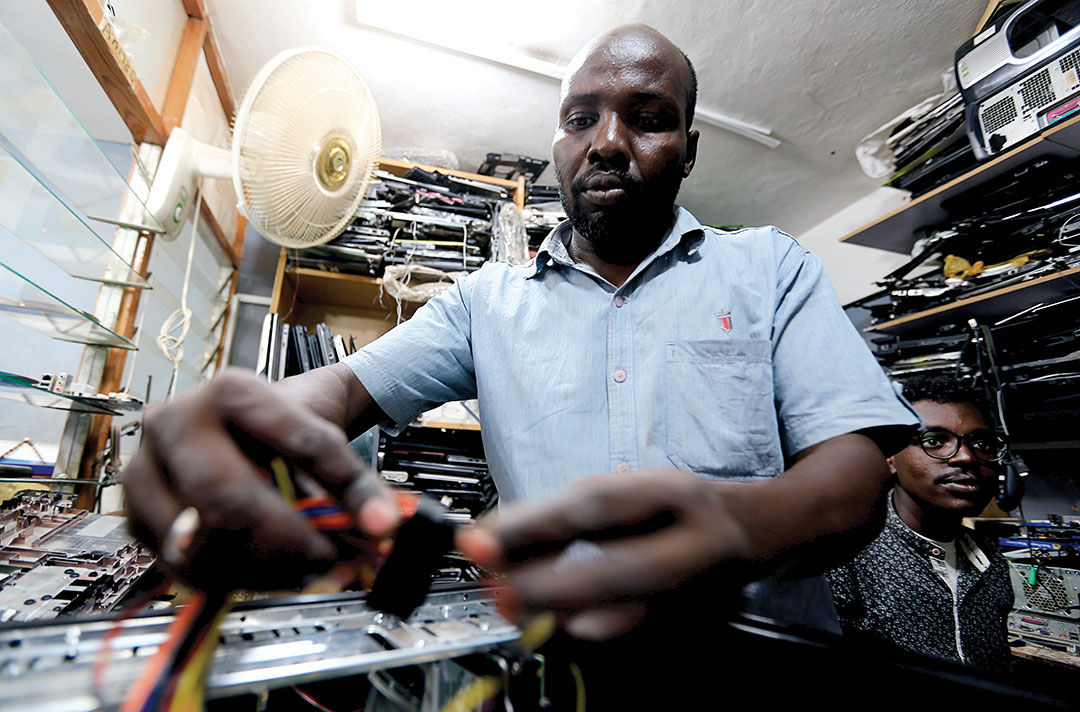Stopping online propaganda by extremists takes more than just shutting down the messenger
ADF STAFF
For years, the blueprint for countering extremist propaganda was straightforward: Insist to followers that their beliefs are wrong and that they are suffering as a result. Tell them to abandon their cause and that they will have better lives if they change sides. Repeat the countermessages as often as necessary.
The only problem with countermessaging is that it rarely works.
Dr. Cristina Archetti, author of “Terrorism, Communication and New Media: Explaining Radicalization in the Digital Age,” says that developers of anti-extremist messaging need to abandon old models.
“To start with, from reports on how to counter online radicalization to governments’ calls for taking extremist material off the internet, there is a strong focus on messaging,” wrote Archetti. “Whether this means fighting the terrorists with the right countermessage or removing their extremist message, this approach reflects a woefully outdated model of public-media interactions.”
Archetti said that such a model, sometimes referred to as the “hypodermic needle” type of communication, was developed after World War I, when the victors believed they had won at least in part because of the persuasive powers of propaganda.

Such a model is now widely recognized as simplistic and naive. As Archetti noted, “We can all realize in the immediacy of our everyday lives that we do not buy every commodity advertising messages tell us to buy.”
Today, extremists use the internet and social media to recruit followers, usually people in their teens and early 20s. The extremists use high-quality videos to convince these young people that they are victims of discrimination because of their beliefs.
“ISIS has proved fluent in YouTube, Twitter, Instagram, Tumblr, internet memes and other social media,” reported The Guardian of the United Kingdom. “Amateur videos and images are also being uploaded daily by its foot soldiers, which are then globally disseminated, both by ordinary users and mainstream news organizations hungry for images of a conflict their own cameras cannot access.”
These target audiences can be found in regions of the world where jobs for young people are few, and dissatisfaction with the government and the status quo is high. Governments and information tech specialists have been pulled into the fray, forced to try to stop the extremists’ messages while trying to develop countermessages.
But countermessaging is complicated. The messages must be worded in such a way that they sympathize with and relate to the target audience. Countermessages must have a personal touch, and they have to point out that the extremists’ doctrine is based on falsehoods and distortions.
FIRST-INSTINCT APPROACHES
Researchers say that the first-instinct approaches to countering extremists’ messages on the internet have focused on technical solutions, with the theory that removing or blocking such material will fix the problem. In their 2009 study, “Countering Online Radicalisation, A Strategy for Action,” researchers Tim Stevens and Dr. Peter R. Neumann said such a technical approach is “bound to be crude, expensive and counterproductive.”
Stevens and Neumann said that any strategy aimed at countering online radicalization must create an environment in which the creation and consumption of such messages becomes not only more difficult technically, but also unacceptable and undesirable. They noted that governments alone cannot stop online extremist messaging. “It is vital to capitalize upon the potential contributions of all stakeholders, including internet companies and internet users.” They also recommended:
Deterring producers: The selective use of website and social media takedowns, along with the prosecutions of the producers responsible, “would signal that individuals engaged in online extremism are not beyond the law.”
Empowering online communities: Creating an “internet users panel” to improve reporting mechanisms and complaints procedures would give users a voice in the anti-extremist strategy.
Reducing the appeal of the message: “More attention must be paid to media literacy, and a comprehensive approach in this area is badly needed,” the authors wrote.
Promoting positive messages: Establish an independent startup fund to provide money for “grassroots online projects” aimed at countering extremism. “The aim is to capitalize on the enthusiasm and goodwill of communities around the country who might be willing to invest time and commitment but need limited financial support in order to get their ideas on the net.”
Other experts also have recommended providing money for grassroots online projects. In “Jihad Trending: A Comprehensive Analysis of Online Extremism and How to Counter it,” authors Ghaffar Hussain and Dr. Erin Marie Saltman urged the establishment of a central body that offers seed funding and training for grassroots online counterextremism.
“Challenging extremism online should be a joint effort between public, private and third sector stakeholders,” the authors said. They also suggested:
- Establishing a forum that deals with online extremism and brings stakeholders from key sectors together.
- Improving digital literacy and critical consumption skills in schools and communities.
- Encouraging the establishment of a social media outlet that clarifies government policies and debunks propaganda.
- Conducting a mapping exercise to explore current efforts to tackle extremism online and identify partners who could be given support to develop an effective online presence.
- Conducting more research into how extremists are using the internet to spread propaganda.

ACKNOWLEDGE THE GRIEVANCES
A common point in all strategies for countering extremists’ messages is that no one specific countermeasure works in all cases.
In his report, “Online De-Radicalization? Countering Violent Extremist Narratives: Message, Messenger and Media Strategy,” political scientist Omar Ashour said it is critical to “address every dimension as well as to tailor the message to different audiences, especially to young people and their concerns.”
Extremists figured out years ago that going after today’s youthful target audiences by posting long sermons on the internet was not working. Instead, they switched to modern propaganda — internet videos and short messages posted on social media. And they’ve gotten good at it.
A tailored counternarrative must avoid oversimplification, shallowness and generalizations, because such shortcuts invite what Ashour calls “strike-backs.” The countermessages should be attractive and encouraging, but also acknowledge the validity of some — even all — of the grievances, such as a lack of jobs and economic opportunities. The countermessage must offer alternative ways to address the grievances, while emphasizing “the legitimacy and effectiveness of non-violent strategies.”
Even though these approaches are not new, “the identity of the message-bearers makes a big difference,” Ashour said. He mentioned an instance in which an Islamic group accepted counternarratives after rejecting them previously because they were finally delivered by people they knew and trusted.
After constructing the countermessages and coordinating with the chosen messengers, the next task is publicizing and promoting both of them in the media. Ashour notes that “many of the battles won by violent extremists were on media fronts.” The media dimension of the counternarrative requires three steps:
Analyze the counternarratives available and highlight their strengths and appropriateness for the audience in question. Evaluate the potential impact.
If necessary, translate the message. Then summarize and simplify it, if needed, to suit the streamlined nature of some forms of media. Use texts and multimedia forms, such as online videos and audios.
Introduce the messengers, their background and their experiences.
DON’T TAKE SHORTCUTS
Countering online propaganda is not a simple, mass-media task. A U.S. State Department report, “Countering Extremist Speech Online,” outlines six suggestions for confronting extremist recruiters:
- Don’t take shortcuts: Although a strategy to counter extremist narratives online can be useful, community-level engagement remains the cornerstone of getting a message across. Counter the presence of recruiters in communities.
- Use broader countermessaging: It must be paired with technical solutions, including website shutdowns and content filtering. Shutting down websites is often temporary at best, because extremists simply start up new sites. Technical measures have their place, but they must be used surgically in support of larger prevention and countering of violent extremism measures.
- Tailor your message to fit your audience: Countermeasures that may seem persuasive and reasonable to moderates can backfire when used on an audience that is more politically charged. People responsible for composing countermessages must understand the perspectives of audiences that have already become at least partially radicalized.
- Provide logical, honest alternatives to false extremist stories: Research indicates that people are more likely to listen to and believe stories that provide honest alternatives to their beliefs. For example, when extremists promote false narratives, such as that the United States targets civilians in Iraq and Syria, it is not enough to deny the claim. An accurate countermessage must be provided.
- The messenger matters: Even moderate populations that reject most extremist ideology also will reject counterinformation from sources they do not trust. The countermessages must come from voices within their own communities. Those speakers must have influence and respect — qualities that often develop slowly.
- Counter incorrect beliefs with affirming correct information: Simply rejecting extremists’ claims can have the opposite effect of reinforcing them. Countermessages must have accurate claims and facts that go beyond simple rebuttals.
LOOK FOR THE REASONS
In The Atlantic magazine, staff writer Graeme Wood said that Westerners who accuse Muslims of blindly following “ancient scriptures” accomplish nothing in terms of getting to the roots of extremism. True scholars, he said, know better.
“Look instead, these scholars urged, to the conditions in which these ideologies arose — the bad governance, the shifting social mores, the humiliation of living in lands valued only for their oil,” wrote Wood.
Another strategy, Ashour said, is to identify specific historical events to give the political dimension legitimacy. The narrative focuses on “the glorification of violent acts, including terrorism, as well as their perpetrators.” An example would be the highly violent videos that some extremists have posted on the internet, which have included torture and beheadings.
The narrative emphasizes what it calls religiously legitimate actions or reactions to political grievances and social oppression. In the case of al-Qaida, those actions are emphasized as individual religious duties.
FINDING OUT WHAT WORKS
Regardless of what approaches are used to counter extremists’ messages, the results should be closely monitored. For instance, providing money for grassroots initiatives without determining whether they are effective is wasteful.
“There can be no question that many of the projects that might receive support will be unsuccessful,” wrote Neumann and Stevens. “This should come as no surprise. The internet, after all, is a hugely dynamic environment, and it is not at all clear why certain websites fail while others succeed. Even if it was possible to find an explanation, new technologies and modes of interaction might soon make it irrelevant.”
The two authors added that they encountered “a tremendous amount of interest and goodwill” in doing their research. “The internet industry, for example, may have concerns about heavy-handed government regulation, but it seems quite ready to make a positive contribution where this is possible and constructive. Such expressions of intent should be actively drawn upon in constructing a truly comprehensive strategy.”
They noted that anti-extremist messengers need to be open to evolving technologies and modes of interaction.
“The rise of user-generated content, for example, is often seen as a danger, because much of the material involved in online radicalization is made available in this way,” they wrote, adding “not only is user-generated content here to stay, if properly understood it can become a powerful force in countering radicalization.”

